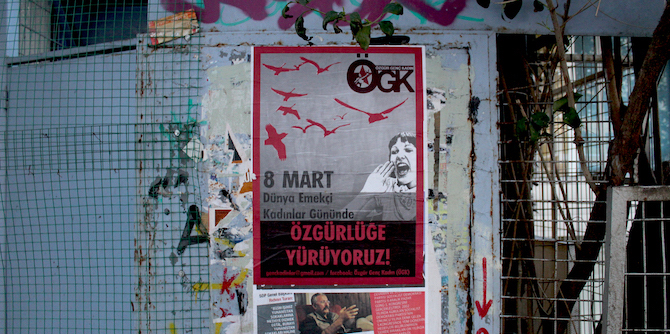by Michael McCall

By now, the wars in Syria and Libya should by now be considered two manifestations of one larger conflict. After Turkey suffered losses at the hands of the Russian-backed Syrian army, the UN-recognised government in Tripoli routs Khalifa Haftar’s forces from the capital with Turkish support. When Assad appears as secure as ever, Russia increases recruitment of Syrian mercenaries to fight in Libya. What do these patterns mean? A set of coalitions have solidified, and the fortunes of war in both Libya and Syria are beginning to appear to be deeply connected by the larger rivalry between Russia and Turkey. Most importantly, this rivalry, and how it is pursued regionally, may be indicative of how geopolitical competition in the Middle East will play out in a future with diminished American hegemony.
It is not bold to claim that the political futures of Syria and Libya will not be decided in Damascus or Tripoli, respectively. Although the conflicts in Syria and Libya differ in many respects, especially with regards to foreign intervention, they have come to share one common trait: a proxy competition between Turkey and Russia, each side further supported by a constellation of geopolitical fellow-travellers. A quick recap: in Syria, Turkey supports a subset of rebel forces, while the Russians back the Assad government. In Libya, Turkey is a strong supporter of the UN-recognised government in Tripoli, while Russia is the most effective supporter of Khalifa Haftar.
Previously, the geographic distance and limited state (or non-state group) capacity between Syria and Libya rendered any kind of sustained connection between the two conflicts impossible, save the moral support and mutual identification stemming from the shared experiences of the Arab Spring. Geopolitical imperatives fragmented international ideological coalitions, making the international response initially far more aggressive in Libya than Syria. Now, a new set of coalitions have crystallised and remain coherent across the contextual boundaries that separate the Libyan and Syrian conflicts. Turkey transported Syrian mercenaries to support the internationally-recognised government in Tripoli against Haftar’s offensive. Russian mercenaries have played a critical role in Haftar’s same offensive on Tripoli, many of which undoubtedly served in Syria as well. This human flow represents the most potent demonstration of interconnectivity. It is not ideological conviction that drives flows of combatants from one place to the other, but rather a ruthless realpolitik logic that adjusts military commitments across borders to in response to shifting equilibria on the battlefield.
There are other players in each conflict, of course. Egypt and the UAE have expended numerable resources in Libya in support of Haftar. Egypt even proposed its own peace initiative for Libya. In Syria, Iranian support resuscitated the Assad regime, just as much if not more than Russia. These other players have high profiles. The difference is that Russia and Turkey have diplomatic capital they’ve accumulated with all sides; they are simultaneously indispensable in any serious diplomatic process and they pursue pragmatic ends rather than blatant partisanship. Egypt and the UAE cannot compete, but Iran would be a close contender in this regard: it too pursues a pragmatic agenda, but lacks the same international legitimacy that Turkey and Russia enjoy. This places Turkey and Russia into a class of their own.
This partially accounts for the remarkable cordiality demonstrated between Russia and Turkey. Despite occasional spats, as when Turkey shot down a Russian jet over Syria, relations between the two have proven resilient, particularly as Turkish ties with NATO countries are strained. The Turkish purchase of Russian S-400 missile systems, despite its long-standing NATO membership and American objections, indicates the depth of the strategic relationship forged between the two countries even when they support rival factions in third countries. The direct bilateral relationship between Turkey and Russia seems to follow a different logic than their regional competition because it takes place in an entirely different strategic context. Both Turkey and Russia are primarily considering their respective relations with the United States when dealing with each other, rather than foregrounding their regional interests.
Elevating the cases of Syria and Libya to understanding regional structures, what does this mean for what a post-American Middle East would actually look like? American preponderance in the Middle East has lasted so long, the structural effects of US retrenchment are only now finally beginning to establish a discernible pattern. Extrapolating, proxy conflicts between regional powers would be more common, with these conflicts easily permeating nominally sovereign borders according to strategic logic. They would be probably be contained to countries already experiencing instability, as Turkish and Russian support have proven to be reactive within existing conflicts rather than proactive to provoke new ones.
All these characteristics demonstrate that this competition is first and foremost geostrategic rather than ideological. The Middle East continues to be unusually affected by major powers, and that should not be expected to change in the near future. What has changed is the distribution of that influence and the level of competition it engenders. In 1991, neither Russia, Turkey, nor few others could project any kind of serious power in the Middle East, leaving the United States the unquestioned regional hegemon. Today, peace conferences for Syria are held in Sochi or Astana without any American participation to speak of. Power is still imposed from outside, but its source and effect are fundamentally different.
Syria and Libya are the first manifestations of a new regional struggle that has only had the opportunity to emerge in the wake of American retrenchment. To a large degree, the two conflicts have merged into one larger geopolitical struggle, with substantial and growing strategic and human connections that have outstripped anything seen in the past decade of war in both countries. Although there are several major regional rivalries, the competition between Turkey and Russia is novel because it is indifferent to and unaffected by American power, and thus is the most indicative of what the future could hold. Truth be told, that future looks bleak.







3 Comments